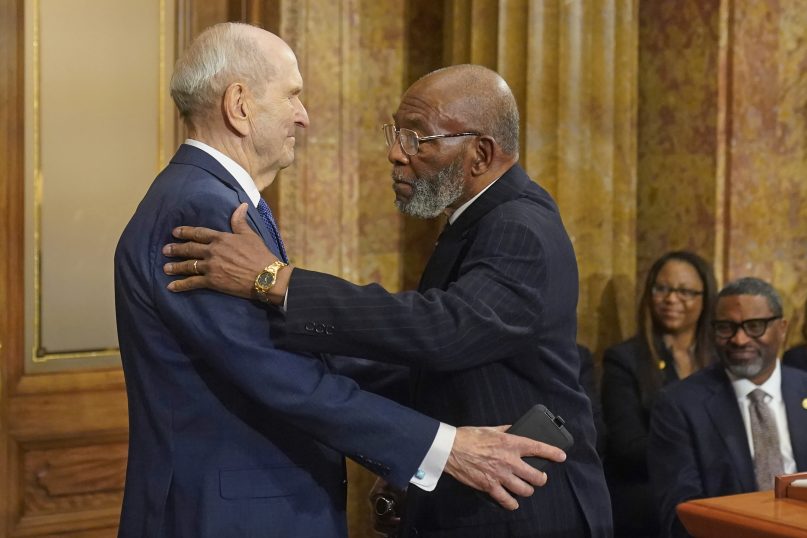(RNS) — Last week marked the four-year anniversary since Russell M. Nelson assumed leadership of The Church of Jesus Christ of Latter-day Saints, and it’s been quite an unexpected ride.
When he became the president in January 2018, the general consensus seemed to be that people were not expecting major changes. He was described as a “company man,” someone who had uneventfully risen through the ranks of church leadership for decades without making waves.
NBC News said the 93-year-old Nelson “isn’t expected to move the church in major new directions,” while the Chicago Tribune surmised “Nelson’s record during his three decades in church leadership suggests he will make few changes as he upholds church teaching and seeks to draw new members.” And here’s the headline from The Wall Street Journal: “Mormon Leader Thomas S. Monson Dies; Likely Successor Unlikely to Alter Church’s Course.”
I believed that too. I was underwhelmed by Nelson’s initial news conference, particularly that his response when asked about the roles of women in the church amounted to “you can know I love women because I have nine daughters!” It was the typical and disappointing Mormon patriarchy line that women are wonderful because they are wives, mothers and daughters who make life better and easier for men. Yawn.
If I was guilty of expecting little from a nonagenarian company man, I’ve had cause to repent. I’m very glad to have been wrong about President Nelson. In a denomination that has for the last half-century implemented change glacially if at all, he has moved forward on a number of fronts. Here are my top 10.
- Reversing the 2015 LGBT exclusion policy. The church still has mountains of work to do in treating LGBTQ members as equals who are welcomed into full fellowship. (See last week’s Brigham Young University headline for one example, or this poignant article about singer David Archuleta trying to reconcile staying a Latter-day Saint when he is now out of the closet.) Also, the 2019 reversal of the 2015 policy just put us right back where we started: Once again, children of gay couples could be baptized and blessed, and once again, gay members were not subject to automatic excommunication for being in a relationship. As such, that hardly seems like progress. But the reason this policy reversal is my No. 1 change is that it demonstrated something we almost never see in modern Mormonism, which is a prophet visibly and decisively changing direction in a very short period of time. In early 2016, then-Elder Nelson was the one who most publicly defended the exclusion policy as God’s will; in 2019, as prophet, he heralded its reversal as God’s will. Confusing? Yes. But also promising. The reversal showed that everything was — and is — on the table for change. What else can and will shift to make a more open and affirming life for LGBT members of the church?
- Giving women a more active role in ritual life. In 2019, the church changed its endowment ceremony to give more authority to women, taking out a promise that women would “hearken” to their husbands while men would hearken directly to God. It also expanded the role of Eve (and therefore all women). Months later, the church announced women and girls could be official witnesses to official church ordinances, including temple baptisms and sealings. At the ward level, President Nelson has promoted greater parity with more women serving on ward councils. These are small changes that fall far short of structural equality for women in the church, but after many years with no forward movement at all, it’s heartening to see even a little progress.
- Moving toward a more diverse international leadership. One of Nelson’s very first changes was to call two new apostles who were not white men from the U.S. or Europe — a first in LDS history, believe it or not. He has also expanded the international representation in the lower Quorums of the Seventy. The church’s leadership is still predominantly American and white, but some change is finally happening. Nelson has also forged an ongoing relationship with the NAACP and spoken out against racism, both in the world and in the church.
- Making improvements to the missionary program. Nelson has de-emphasized the old “tough it out” approach to mission life, in which missionaries were only permitted to call home twice a year. Now, they can engage in weekly video chats with their families and the church is providing more mental health services for missionaries who experience anxiety or need to return early. As well, he initiated the shorter “service mission” for some young people who will continue to live with their families at home. In 2021, that option to do a short-term service mission was also given to retired senior members all over the world. Also — finally! — many female missionaries are permitted to wear pants and men can branch out ever so slightly from the 1960s white-shirt-and-tie combo.
- Balancing the youth program. At the start of 2020, the church ended its century-long official relationship with the Boy Scouts. It also overhauled its own youth program worldwide and began giving girls an equal budget in every unit around the world. This has had two immediate benefits — for starters, girls don’t have to feel like afterthoughts because their budget is no longer merely a fraction of what’s allotted for the boys. And second, the boys’ program is more standard everywhere in the world — unlike the old days, when nations that had access to Boy Scout troops and camps had amazing programs and boys in poorer nations did not.
- Two-hour church. Need I say more? Bring it on!
- Adapting skillfully to a global pandemic. I’ll always be grateful to Nelson for taking the COVID-19 pandemic seriously from the very beginning. He shut down meetinghouses and temples and kept them closed for months, only gradually reopening while listening to public health experts about what was safe. He closed General Conference to the public, promoted the use of masks, encouraged members to get vaccinated and modeled vaccination compliance. He’s taken a lot of flak for this from right-wing members.
- Ending the enforced vulnerability and potential exploitation that have been bishop’s interviews. The long-standing system of youth having to enter a closed office with a middle-aged man to discuss, among other things, their sexual behavior is potentially dangerous and has resulted in some terrible cases of the abuse of power. In early 2018, just two months into Nelson’s tenure, the church changed this policy so youth can now be accompanied by an adult of their choice into any interview with a church leader. What’s more, the new policy also applies to adult women, many of whom have long been uncomfortable with the experience of going in alone to speak with LDS leaders. (This includes me.)
- “Ministering” replacing home and visiting teaching. I like the new “forget the checklist” approach of the new ministering program. It’s more relaxed, relational and geared toward fellowship rather than trying to cram a doctrinal lesson into an awkward social encounter just to say you’ve done it. We have a long way to go to fully tap the potential of the ministering program in the church, but the early fruits have been good.
- Ending the Hill Cumorah Pageant and other pageants. I know many people have loved these spectacles through the years, with fond memories of attending them as children. As a convert, I don’t have those associations, so I went to the Hill Cumorah Pageant in the summer of 2019 with no prior experience. Though I was expecting to enjoy the show and feel sad it was ending, I left feeling the church probably should have discontinued it years ago. It was stilted, cheesy and racially problematic. I hope the church invests in new kinds of productions and intergenerational “destination” pilgrimage experiences for Mormons the world over — but the Hill Cumorah Pageant was a cultural relic of the past.
Those are my personal top 10 (so far). As I write, I’m fully aware some of these feel like small concessions in the midst of serious inequalities, and far more change is needed. Still, if you had asked me four years ago what a Nelson presidency might look like, I would not have seen most of these changes coming.
Related content:
LDS Church Announces new First Presidency Counselors, takes questions on women and LGBT Mormons (1/18)
7 top Mormon news stories from 2019 (12/19)
Top Mormon leaders get Covid vaccine and urge church members to do the same. Will they? (1/21)







